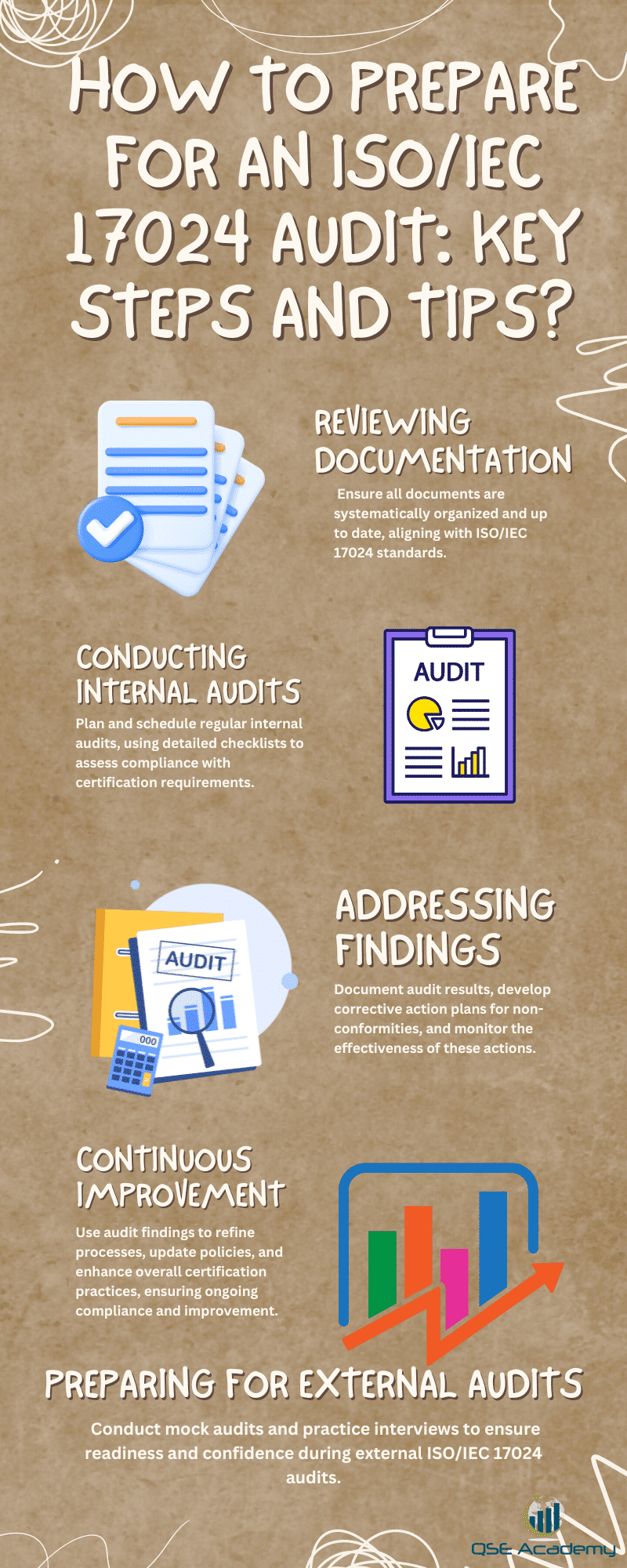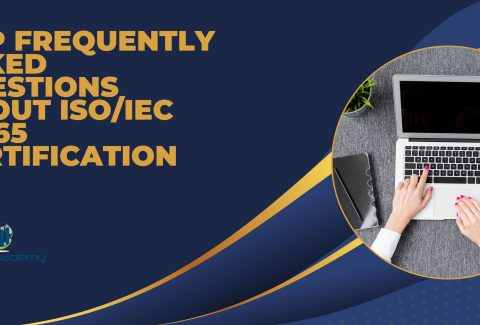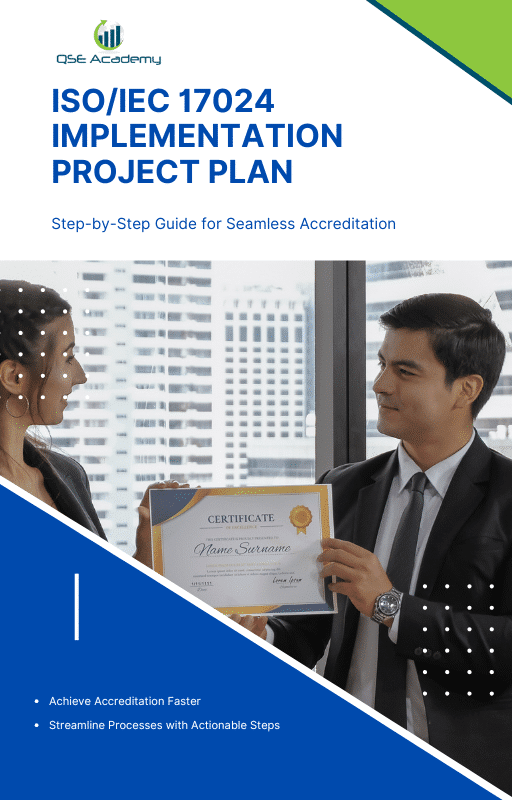How to Prepare for an ISO/IEC 17024 Audit: Key Steps and Tips?
The thought of an ISO/IEC 17024 audit can make even the most seasoned professionals feel a twinge of anxiety. Ensuring that your organization meets the global benchmark for personal certification bodies is essential yet daunting. It’s not just about ticking boxes; it’s about demonstrating unwavering commitment to quality and process integrity.
ISO/IEC 17024 sets a high standard for certifying individuals in various roles and industries, ensuring they are competent and their credentials are legitimate. Mastering its requirements is key to boosting your organization’s credibility and trustworthiness. But what exactly does it take to not just endure, but ace an ISO/IEC 17024 audit?
In this article, we will dissect the intricacies of the ISO/IEC 17024 audit process and guide you through the essential preparation steps. From understanding the audit itself to maintaining impeccable records, developing your team’s competence, and managing the external audit, you’ll gain insights into turning a rigorous examination into a showcase of your organization’s excellence. Get ready to transform apprehension into action as we embark on the journey to ISO/IEC 17024 compliance.
Einführung
ISO/IEC 17024:2012 is an essential global benchmark for personnel certification bodies, providing a structured framework to ensure that certification processes are carried out in a consistent, comparable, and reliable manner across various industries and regions. This international standard specifies requirements for the organization and management of the certification process, as well as for the development and maintenance of certification schemes for persons.
As the demand for certified professionals grows in an ever-competitive environment, the importance of a reliable personnel certification program cannot be overstated. Certification bodies that adhere to ISO/IEC 17024 not only gain international recognition for their certification schemes but also commit to a continuous process of improvement and transparency, ultimately ensuring the competence and expertise of their certified individuals.
This article aims to serve as an authoritative guide for those engaged in personnel certification bodies, focusing on the crucial aspect of preparing for an ISO/IEC 17024 audit. It highlights the key steps and provides practical tips to ensure your organization meets the standard’s requirements. With an emphasis on facts and actionable information, the guide is intended to streamline the preparation process for your upcoming audit and align your personnel certification programs with internationally recognized best practices.
Understanding the ISO/IEC 17024 Audit Process
Understanding the ISO/IEC 17024 Audit Process involves examining the systematic approach used to evaluate a certification body’s operations against the international standard ISO/IEC 17024:2012, which sets the benchmark for personnel certification. Certification bodies are responsible for ensuring that individuals meet specific competencies within various professions and industries. The audit process is aimed at verifying that the certification body operates in a consistent, comparable, and reliable manner.
Objectives and Principles
The audit’s primary objectives are to confirm that the certification body adheres to the defined ISO/IEC standards, to validate the integrity and credibility of the certification processes, and to foster continuous improvement. Auditing rests on several key principles, including impartiality, competence, responsibility, and evidence-based decision-making.
Types of Audits
ISO/IEC 17024 audits can be categorized into internal and external audits.
- Internes Audits are conducted by the certification body itself or on its behalf to monitor its own processes and procedures. These are aimed at self-assessment and improvement.
- Externe Audits encompass:
-
- Initial Certification Audit: This is performed to establish that the certification body meets all the standard’s requirements before it can begin operating.
-
- Überwachungsaudits: These are periodic assessments to ensure ongoing compliance.
-
- Re-certification Audits: Occur at the end of the certification cycle to verify continued adherence to the standard.
Importance for Certification Bodies
ISO/IEC 17024 audits are crucial for maintaining a globally recognized level of practice and improving the certification body’s ability to operate in an increasingly competitive environment. The audit process enhances trust among stakeholders and clients by ensuring that the certification of persons is impartial, consistent, and based on rigorous standards. It supports certification bodies in offering valuable and credible personnel certifications that are aligned with professional and industry needs.
Ensuring Compliance and Improvement
The audit process is a key part of making sure certification bodies meet the ISO/IEC 17024:2012 standard requirements. Through a combination of audit questions, reviews of procedures, and evaluation of practices, auditors verify compliance and identify areas for continuous improvement, thereby upholding the quality and integrity of the certification process.
Initial Preparation Steps
Preparing for an ISO/IEC 17024 audit, which evaluates certification bodies overseeing the certification of persons, requires rigorous effort and strategic planning. The initial steps are crucial to ensure a successful audit outcome and involve several essential actions.
Engagement der obersten Führungsebene
The initiation of this process must begin with the full backing of leadership. The support and commitment from top management are indispensable, as it sets the overall tone for the audit and ensures that adequate resources are allocated.
Audit Preparation Team Formation
Creating a dedicated team is vital to manage the ISO/IEC 17024 audit operation effectively. This team should be comprised of individuals knowledgeable about the ISO/IEC standards, the internal workings of the certification body, and the certification process.
Gap Analysis Execution
A meticulous gap analysis is indispensable, comparing current practices against the stringent ISO/IEC 17024 requirements. This step assists in unveiling areas that need improvement and helps in charting a path forward.
Audit Preparation Plan Development
Based on the outcomes of the gap analysis, an Audit Preparation Plan should be developed. This would detail clear objectives, timelines, resource allocation, and budgeting, acting as a roadmap for achieving compliance with ISO/IEC 17024 standards.
Preparation Steps Table
| Schritt | Action Points |
| 1. Leadership Support | Secure top management commitment |
| 2. Team Formation | Assemble a knowledgeable audit preparation team |
| 3. Gap Analysis | Evaluate current practices against ISO/IEC 17024 standards |
| 4. Audit Plan | Develop a detailed plan with objectives, resources, and timelines |
It’s imperative that these steps are not only comprehensively planned but also meticulously executed to ensure a seamless audit process and eventual ISO/IEC 17024 compliance.
Documentation and Records Management
In the pursuit of achieving and maintaining ISO/IEC 17024:2012 certification, a certification body must prioritize effective documentation and records management. This is essential for ensuring the transparency, consistency, and traceability of the certification process for persons.
Organizing and reviewing documentation constitutes one of the fundamentals of a properly managed certification body. Key documentation must always remain current, which necessitates robust document control procedures and meticulous version management systems. To maintain a high standard, the following documents should be prepared and routinely checked for updates and relevance:
- Quality manual: This core document outlines the certification body’s quality policies and objectives, providing a guide to its operations and the maintenance of quality standards.
- Organizational structure and responsibilities: Clearly defined roles and responsibilities within the certification body are crucial for efficient functioning and accountability.
- Policies and procedures: These documents should cover all processes related to the certification schemes, ensuring that they are conducted in a consistent and standardized manner.
- Records of competence and training: Meticulous records must be kept to verify that all personnel involved in the certification process are suitably trained and competent.
Besides maintaining the accuracy and contemporaneity of documentation, ISO/IEC 17024 also mandates stringent data integrity and security measures. Data protection is paramount to safeguard the personal information of applicants and certified individuals. To this end, confidentiality agreements and protocols should be in place to prevent unauthorized access or breaches, thereby promoting trust and confidence in the certification process.
In summary, documentation and records management is a non-negotiable aspect of a certification body’s commitment to upholding ISO/IEC 17024:2012. By ensuring that all involved documentation is controlled, secured, and regularly reviewed, a certification body demonstrates its adherence to the required standards and its commitment to a high-quality certification process for personnel.
Ausbildung und Kompetenzentwicklung
In the dynamic realm of personnel certification, the importance of rigorously structured training programs cannot be understated. As mandated by ISO/IEC 17024:2012, certification bodies must demonstrate a steadfast commitment to developing and implementing comprehensive training plans tailored to ensure the competence of their certification personnel.
To bolster organizational adherence to ISO/IEC standards, internal awareness sessions form a cornerstone strategy. These sessions serve as educational conduits, disseminating the critical intricacies of ISO/IEC 17024 requirements throughout the workforce. Mastery of these requirements isn’t merely encouraged for compliance; it’s pivotal for maintaining a state of perpetual audit readiness, positioning the certification body favorably in a competitive environment.
A systematic approach to competence assessment and performance evaluation is equally crucial. Certification bodies are tasked with conducting regular evaluations to affirm the upskilling of their personnel – a practice that reflects the evolving needs of the market and the high benchmark for personnel certification. Meticulous documentation of training initiatives and evaluation outcomes assures that a tangible trail of continuous improvement and diligence in skill enhancement is maintained.
This proactive investment in personnel development not only fortifies the certification body’s reputation but also assures that the organization’s employees can withstand the scrutiny of an ISO/IEC 17024 audit.
Conducting Internal Audits
Conducting internal audits is an essential component in the ISO/IEC 17024:2012 certification process for personnel certification bodies, ensuring they meet the required standard requirements. This phase embodies a systematic examination of the certification body’s procedures and practices, aligning them with the established benchmark for personnel certification.
Planning and Scheduling Internal Audits
Before embarking on the audit, it’s crucial to have a comprehensive internal audit schedule. This plan ensures all necessary areas within the certification body are reviewed periodically. Selection of qualified internal auditors who are well-versed in ISO/IEC standards, the certification program, and the certification schemes for persons is fundamental. These auditors require adequate training, possibly through internal auditor training courses or e-learning programs.
Internes Audit Prozess
The next step involves creating detailed audit checklists and tools, tailored to the specific areas being audited. These instruments should cover all audit questions and are vital for a thorough and efficient auditing process.
Executing the Audits
During the audit, auditors review and compare operational practices against the documented procedures and standards. The goal is to identify any gaps or areas of non-compliance within the certification process and personnel certification programs. Auditors must be impartial to maintain the integrity of the findings.
Reporting and Addressing Findings
After the audit, findings are meticulously documented, highlighting conformities as well as any discrepancies that require attention. Subsequently, the certification body must address these findings by planning and implementing corrective and preventive actions. This step is critical in upholding a competitive environment while continuously improving body employees’ adherence to internal and ISO/IEC guidelines.
Following Up
Once corrective and preventive measures are implemented, a follow-up audit may be necessary to verify the effectiveness of these actions, thereby completing the audit cycle.
A successful internal audit enhances trust in the certification body and reinforces its commitment to a robust certification program for personnel.
Preparing for the External Audit
Preparing for an external audit under ISO/IEC 17024:2012, an international standard that sets the benchmark for personnel certification programs, involves several crucial steps to ensure a certification body is fully compliant with the standard requirements. The process begins with a pre-audit meeting, an essential step where the scope and objectives of the upcoming audit are discussed in detail. This serves as an opportunity to clarify any doubts and address specific concerns the certification body might have.
| Pre-Audit Actions | Beschreibung |
| Pre-audit meeting with the certification body | Discuss audit scope, objectives, and any specific concerns |
| Final review of documentation and records | Ensure completeness and accessibility; check for discrepancies |
| Staff preparation | Conduct mock audits and ensure readiness |
Subsequent to the pre-audit meeting, a final review of documentation and records is critical. This step ensures that all necessary documents, including internal audits, certification schemes, and records of training programs, are complete, accurately maintained, and readily available for review. It’s essential to rectify any detected discrepancies or gaps prior to the audit.
Lastly, preparing the staff directly involved in the certification process is of utmost importance. This can include conducting mock audits and practice interviews to foster confidence and ensure that all employees are well-versed in their roles within the certification program. The intent is to establish a clear understanding of the audit questions and requirements, which helps in demonstrating the certification body’s competence and adherence to ISO/IEC 17024:2012 during the external audit.
By meticulously preparing for the external audit, the certification body positions itself to not only pass the audit but also enhance its operations, reflecting a higher standard of excellence in a competitive environment.
During the Audit
An ISO/IEC 17024 audit ensures that certification bodies running personnel certification programs adhere to high-quality standards. This detailed verification process is critical for maintaining the integrity and value of certification schemes.
Opening Meeting
The audit process commences with an opening meeting where the lead auditor introduces the audit team members. This enhances transparency and sets clear expectations. The scope and objectives of the audit are reaffirmed to align both the auditors and the body undergoing the review.
Durchführung des Audits
Once the stage is set, auditors require access to relevant documents and interviews with personnel. Certification bodies are expected to provide both exhaustive and accurate documentation. Full cooperation with the audit team is paramount to cover the extensive checklist that encompasses the entirety of the certification operation.
Communication During the Audit
Open lines of communication are vital during auditing. Certification bodies must facilitate a transparent dialogue, promptly addressing questions or clarifications the audit team might have.
This systematic review ensures the certification body meets ISO/IEC 17024:2012 standard requirements. Catching non-conformities early allows the body to maintain best practices and continuous quality improvement in a competitive environment.
The process is not just a hurdle to clear, but an opportunity for the certification body to enhance operational processes, strengthen the value of its certification schemes, and uphold the benchmark for personnel certification.
| During the Audit | Beschreibung |
| Opening Meeting | Introduce audit team, confirm scope and objectives. |
| Durchführung des Audits | Ensure access to documents/personnel, provide accurate info. |
| Communication with Audit Team | Maintain open communication, address issues promptly. |
By adhering to these stages with diligence, certification bodies exemplify their commitment to excellence and maintain the extensive trust placed in their certification programs.
Post-Audit-Aktivitäten
After an ISO/IEC 17024 audit, it is essential for the certification body to actively engage in post-audit activities, ensuring a commitment to excellence and adherence to ISO/IEC standards. Reviewing the audit report is the first step, where understanding the nuanced findings and recommendations paves the way for enhancing the personnel certification process. The audit team should be involved in thorough discussions to clarify any uncertainties and gain insights into the audit results.
Developing a corrective action plan follows, which is crucial for addressing the non-conformities identified during the audit. Ensuring these actions are not only implemented but also effective falls within the realm of the organization’s responsibilities. It is imperative to monitor the impact of corrective actions to verify that they yield the desired improvement in the certification process.
Continuous improvement is the cornerstone of maintaining a competitive edge. Certification bodies can leverage audit findings to refine their practices, review and update policies, and optimize procedures. By doing so, they ensure that the internal processes meet the evolving technical competence and ethical conduct expectations to maintain the benchmark for personnel certification set forth by ISO/IEC 17024:2012. The use of e-learning courses for auditors and the continuous education of body employees play a significant role in upholding and advancing this commitment to quality in the certification of persons.
Tips for Successful Audit Preparation
Embarking on an ISO/IEC 17024 audit can be a complex process, and success hinges on meticulous preparation. The key to a seamless certification process lies in addressing the standard requirements with precision. Here are some insightful tips to help certification bodies gear up for a successful audit.
Best Practices for Documentation: Ensure all relevant documents are systematically organized and readily available. Regularly reviewing and updating these records is vital in keeping up with ISO/IEC standards. This not only streamlines the audit but also fortifies the trust in your personnel certification programs.
Effective Communication Strategies: Clear communication is pivotal. Stakeholders should be kept informed, and lines of discussion should remain open to foster a culture of compliance and continuous development. This nurtures an environment where internal audits are viewed as opportunities for growth rather than scrutiny.
Leveraging Technology: Incorporate digital platforms to manage documentation and prepare for your audit. Technology can be a powerful ally, making the process more efficient and improving accuracy. Tools such as e-learning courses can assist in internal auditor training, ensuring the team is well-versed in the nuances of the certification schemes.
Remember, a thoroughly prepared certification body not only stands a higher chance of meeting the benchmark for personnel certification but also establishes its credibility in the competitive environment. Internal auditing is not just about ticking boxes; it’s about demonstrating the robustness of your training programs and certification process.
With these tips, your organization can approach the ISO/IEC 17024 audit with confidence, poised to showcase the integrity and effectiveness of your personnel certification schemes.
Schlussfolgerung
Preparing for an ISO/IEC 17024 audit requires meticulous attention to detail and a comprehensive understanding of the standard’s complex requirements. Certification bodies must ensure that the certification process is impartial, consistent, and based on objective criteria for certification, with a robust internal auditing mechanism in place to oversee operations.
Key steps towards achieving a successful audit include engaging a knowledgeable team of ISO/IEC experts, implementing rich training programs, and developing e-learning courses to enhance the skill set of body employees. Additionally, certification schemes must be clearly defined, managed, and continuously monitored.
Final thoughts gravitate towards the wisdom of ongoing improvement and sustaining conformity with ISO/IEC standards. A proactive approach to maintaining and updating internal audits, coupled with frequent review of audit questions and scheme requirements, places a certification body in an advantageous position in a competitive environment.
Certification bodies should constantly seek novel and effective management consultancy services and internal auditor training courses to adapt and excel in the dynamic landscape of personnel certification. Becoming a benchmark for personnel certification not only demonstrates excellence but also engenders trust among stakeholders, ultimately fostering a culture of quality and reliability in the certification of persons.
Suchen Sie weitere Ressourcen zur ISO 17024?
Wenn Sie diesen Artikel als hilfreich empfunden haben, sollten Sie sich unsere Premium-Ressourcen ansehen, die Ihnen helfen, die ISO 9001-Zertifizierung effizient zu erreichen:
- 📦 Vollständiges Dokumentationspaket für ISO/IEC 17024 2012: Sie erhalten alle wichtigen Vorlagen und Dokumente, die Sie für eine schnelle und einfache Umsetzung benötigen.
- 🎓 Online-Kurs zur ISO/IEC 17024 2012 : Nehmen Sie an unserer umfassenden Schulung teil, um die wichtigsten Konzepte und praktischen Schritte zur Zertifizierung zu erlernen.
- 📋 ISO/IEC 17024 2012 Prüfliste: Laden Sie unsere detaillierte Checkliste herunter, um sicherzustellen, dass Sie jeden Schritt des Prozesses berücksichtigt haben.
Diese Ressourcen sind auf Ihre Bedürfnisse zugeschnitten und gewährleisten einen reibungslosen Ablauf der Zertifizierung. Entdecken Sie sie noch heute und kommen Sie Ihrem Erfolg einen Schritt näher!














